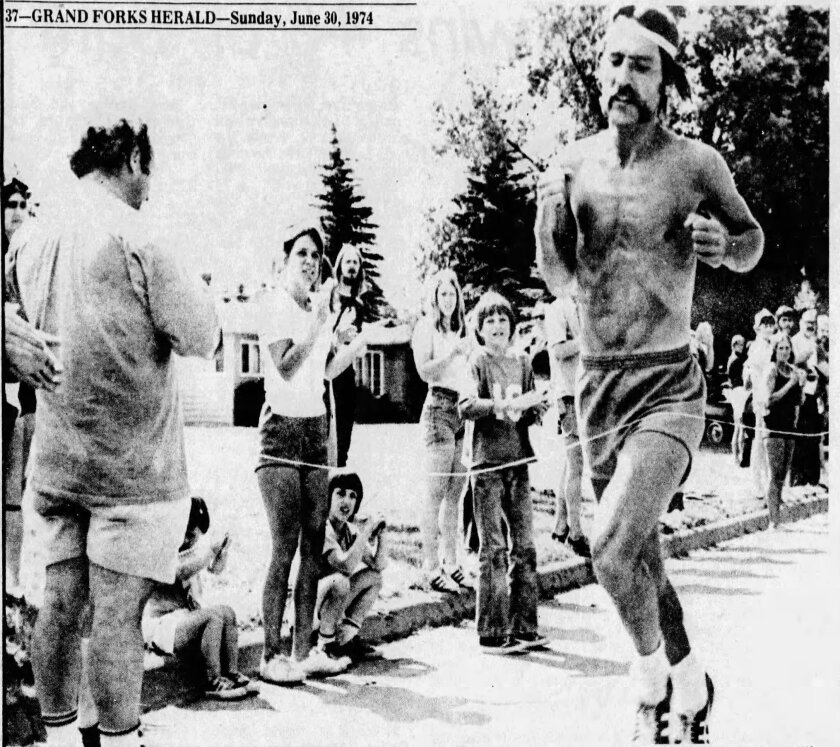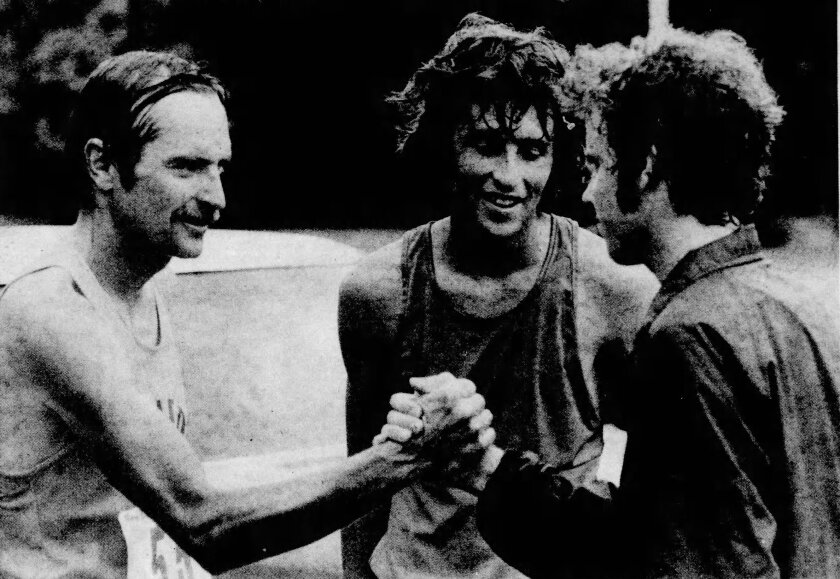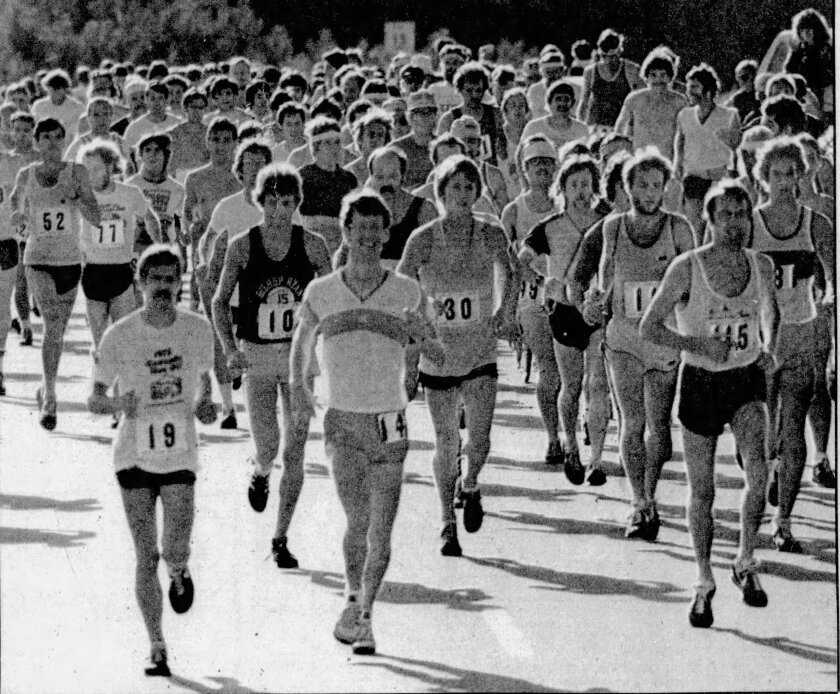GRAND FORKS — It was the little marathon that could, until it couldn’t.
But as it neared its 10-year anniversary, the North Dakota Marathon had a difficult time being recognized in its own community, even with front-page coverage in its daily newspaper. Five years later, as the number of runners dwindled, the marathon itself crossed its own finish line.
Running from 1972 to 1985, the North Dakota Marathon wasn’t a marathon to begin with, at least by distance. The brainchild of Eric T. Parker, a running enthusiast from East Grand Forks, Minnesota, he formed the first race in 1972 after running a 10-miler in Brainerd, Minnesota, and brought the idea back home.
Marathon running was just in its infancy around the region. A marathon in Brookings, South Dakota, was in its third year while Grandma’s Marathon in Duluth (1977) and the Manitoba Marathon (1979) were not even conceived yet.
Did you know?
Dick Beardsley finished second in the 1978 North Dakota Marathon. Four years later he famously finished second in the Boston Marathon.In 1972, there were very few marathons in the U.S. to begin with, though the country was on the verge of a running boom with Frank Shorter winning a gold medal at the Olympics.
That year, the 10th-largest marathon, according to Runners World, was the Island Marathon in Portland, Oregon, with 173 participants. The 25th-largest marathon was at the Drake Relays in Iowa with 89 runners. Only the Boston Marathon had more than 1,000 runners at the time.
The first North Dakota Marathon in 1972 was a 15-mile run , captured by Marv Kluvers of Litchville, North Dakota, with a time of 1 hour, 22 minutes and 56 seconds. Forty-two runners began the race, 29 finished. Moya Cooley of Grand Forks won the women's race — she was the only female runner — and beat 13 men who failed to complete the race.
Kluvers was a middle-distance runner at Dickinson State University at the time, and with a cousin and her husband attending the University of North Dakota, Kluvers came to Grand Forks to run the race.
“It was a good excuse to get away from the farm work for a weekend,” he told the Sports Time Machine.
ADVERTISEMENT
It was a grassroots effort, to say the least.
“No, I didn’t coordinate anything with the police,” Parker said in a 1981 interview recalling the first race . “Man, it (the race) was chaotic. But before we started, I sort of asked the runners if they’d try to run on the sidewalks.”
Chaotic indeed, like a Burlington Northern train that stopped some runners in their tracks during the run. The only water stop was Parker’s mom offering a water hose along the way. “I figured there were enough gas stations and places along the way that the runners could stop to get a drink,” Parker said in 1981. Or the fact Parker, who also was running in the race, had to stop his run and hitch a ride to the finish line so he could help his race official Mark Paulsen record times.
“All he had was a stopwatch,” Parker recalled. “I hadn’t given him a clipboard, paper or pencil to record the times and finishers and the first two guys were already in.”

By 1973, the race expanded to 20 miles. By 1974, runners went the full 26.2-marathon distance and became the state's first official marathon.
In terms of numbers, the highwater mark was in 1978 when 386 runners competed in the full or half marathon. Jim Miller, a former Grand Forks Red River cross country runner who won the half marathon in 1976, won the full marathon for the second year in a row.
Miller’s record-breaking 2:26:58 time in 1978 beat second-year marathoner Dick Beardsley of Wayzata by almost five minutes.
ADVERTISEMENT
Four years later, Beardsley went on to finish second in the Boston Marathon, losing to Alberto Salazar by just 2 seconds in the famous “Duel in the Sun” race. Miller, meanwhile, also made a mark in the marathon world in 2000 when he joined an elite group of runners to have sub three-hour marathon times in six different decades.

The winning North Dakota marathon time continued to drop. Tom Stambaugh (2:26:40 in 1981) and Paul LeBlanc (2:26:17 in 1984) held the men’s record until ultra-marathoner Tom Zimmerman of St. Cloud finished with 2:25:02 in the 1985 finale. In the women’s division, Therese Vogel threatened to go sub-three when she ran a 3:00:18 for the standing record in 1982.
While the names of Miller, Beardsley, Clint Chamberlin, Larry Seethaler, Jan Arenz and Debbie Kosmatka all have their foothold on the marathon’s history, so do Tom Devine Jr. and Joe Cleary, who ran the race every year. According to the Herald, Devine woke up just 10 minutes before the 1985 event but arrived at the starting line in time and finished ninth. His best finish over the course of the North Dakota Marathon was second place.
The downfall
The North Dakota Marathon had a difficult time gaining a foothold in its own community, despite admirable coverage throughout the years in its city’s newspaper. The telling sign of the marathon was in 1981 when a Grand Forks Chamber of Commerce spokesman was asked about the economic impact of the race.
“What marathon?” was the reply.
This was after three of the marathon’s largest fields, including the 292 runners who ran in either the full or half marathon in 1981.
By 1982, the New York City Marathon had grown to 13,599 runners while Grandma’s in Duluth was the nation's seventh largest at 4,086. The budget for Grandma’s had grown to $50,000 for the 1981 race.
ADVERTISEMENT
Meanwhile, the North Dakota Marathon crept along with a $2,800 budget in 1981. It was a hard sell to advertisers and some runners.
“When runners call long distance (the race has been advertised in some running magazines) and ask about the race, I tell them it’s not a great course,” said Cal Murdock, the North Dakota Marathon race director in 1981. “I don’t want somebody traveling here from Colorado or Illinois and ending up being disappointed.”
“It’s a regional race,” Eric Parker said after the 1985 — and eventual final — North Dakota Marathon. “When we started this, the goal wasn’t to make it the biggest or the best or gaudiest race around. It was to have the runners come and enjoy themselves. And I’d certainly like to think that they do.”
The YMCA, the longtime sponsor of the race, was $600 in the red after the 1984 race. When the race didn’t return in 1986, Lyle Oechsle, the executive director of the Grand Forks Y Family Center, said no one seemed to care.
“Nobody has said a word to me about the marathon,” Oechsle told the Herald in 1986. “Nobody has asked why we aren’t running it. And that includes runners. We just haven’t developed a local interest in it.”
In 1982, Bismarck hosted its first marathon and is the state’s longest-running marathon. A year later, Fargo and Minot held marathons as well. In 2005, the Fargo Marathon began and became the state’s largest race.
Editor's note: This story has been updated to correct the spelling of Marv Kluvers.
ADVERTISEMENT
















